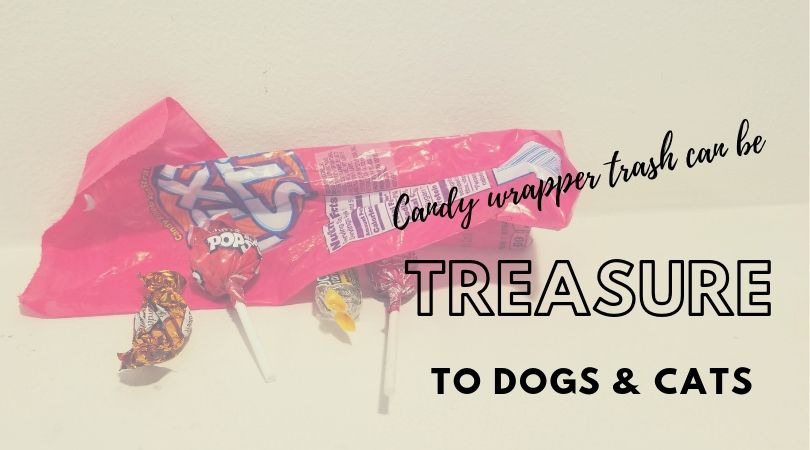Cellophane wrappers, lollipop sticks, plastic spider rings, candy, and all the assorted trappings of Halloween can pose a danger to curious pets.
Imagine this: your inquisitive puppy sticks his nose in the candy bowl and inhales whatever is there (in the way some dogs do – swallow and don’t even chew, before anyone can take it away!). Or, maybe your cat is more discreet and snags those teeny plastic toys when you’re not around. Next, your pet starts gagging and choking.
But then maybe there is vomiting, or diarrhea, or even respiratory problems, and you have no idea what’s wrong.
Candy could be a culprit - and perhaps not for the reason you’d expect.
Chocolate and Other Candy
Most people know chocolate is dangerous for dogs and cats. Even a tiny fingernail size portion can make some pets sick. But not everyone thinks about the dangers of candy wrappers and other Halloween trappings.

According to the Pet Poison Helpline, Halloween week is their busiest. Calls jump by 12 percent.
“Each year we experience a sharp increase in calls around Halloween, especially during the weekends surrounding the holiday,” said Ahna Brutlag, DVM, MS, assistant director at Pet Poison Helpline.
Chocolate is a frequent culprit (pets can’t metabolize the ingredient theobromine in chocolate.) But so are candy corn, hard candies, and even candy wrappers. Lollipop sticks pose a choking hazard. (More about these - plus what you can do to prevent trouble - below!)
Besides choking, the dangers include poisoning and the potential for pancreatitis and seizures. Dogs and cats do not metabolize sugar and other such ingredients the same way as people do.
Symptoms of Poisoning
Yes, those innocent looking candies represent far more than calories when it comes to your pet’s health. They can poison your dog or cat.
If you suspect your pet got into the candy dish, or you know it for a fact, here are some common symptoms of poisoning:
- Vomiting
- Diarrhea
- Unusual behavior like extreme lethargy or agitation
- Seizures
It’s important to know that such symptoms can happen within minutes of ingesting Halloween candy, or it can take a couple of days for the symptoms to present themselves. Because of this unpredictability, it’s best to try to avoid candy ingestion in the first place.
It’s Not Just Candy
 It’s not just candy that can pose a problem. Those little boxes of raisins and glow sticks can also be a hazard. Many dogs can’t digest grapes or raisins, and the fruit poisons them. Plus, candy wrappers and lollipop sticks can look enticing to some pets, but when swallowed, they can cause painful blockages. Chewing on glow sticks can cause mouth pain. Glow necklaces, spider rings, and other novelties can cause injury to your playful kitty, particularly through intestinal blockage.
It’s not just candy that can pose a problem. Those little boxes of raisins and glow sticks can also be a hazard. Many dogs can’t digest grapes or raisins, and the fruit poisons them. Plus, candy wrappers and lollipop sticks can look enticing to some pets, but when swallowed, they can cause painful blockages. Chewing on glow sticks can cause mouth pain. Glow necklaces, spider rings, and other novelties can cause injury to your playful kitty, particularly through intestinal blockage.
And just in case you thought sugar-free candy wouldn’t harm your pet, think again. Xylitol is a popular sweetener that is also dangerous to pets when ingested.
Don’t forget about your trash cans either. As you know, dogs are not above exploring your garbage cans, so if you don’t have lids on your trashcans, then you may want to make a specific designated trash area for candy-related trash. A plastic bag kept in a high cupboard or pantry shelf could work.
As you know, it only takes a second for a curious pet to get into something they shouldn’t. Prepare your family, supervise the goodies, and keep the people treats away from your dogs and cats.
If you do have an emergency, the Pet Poison Helpline number is 800-213-6680. If you must call a pet poison hotline, it's helpful to be ready with:
- Your credit card (there is generally a fee)
- Your pet's age and approximate weight
- Ingredients and amount of item ingested
- A notepad to write down instructions and your case number
And if you have any questions about what your dog or cat should and shouldn’t eat, please contact us!
